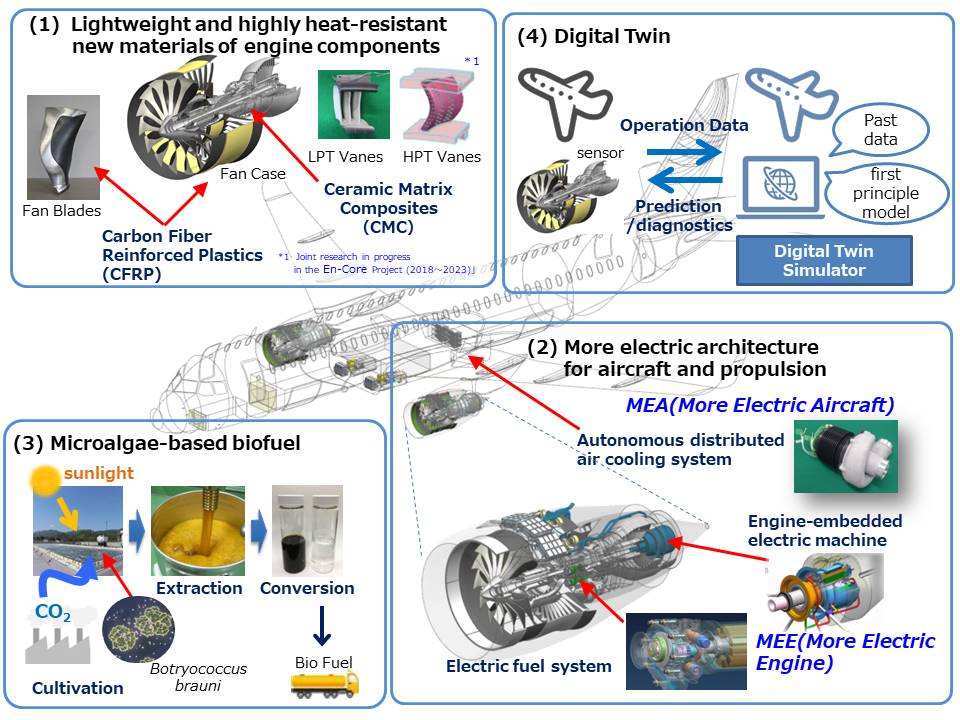Reduction of Net Aviation CO2 Emissions by Optimization of Technology from Material to Operations
IHI Corporation
Outline
The number of aircraft in operation is predicted to almost double by the end of 2038 with the increase in passenger demand. Meanwhile, the International Air Transport Association (IATA) has put forth a target of reducing net aviation CO2 emissions to half those of 2005 by 2050.
The IHI Group aims to contribute to meeting the IATA’s CO2 emissions reduction target through multifaceted challenges such as reducing the weight of engine components, more electric architecture for aircraft and propulsion (MEAAP), development of microalgae-based biofuel, and optimization of operation by Digital Twin Simulation.
Description
[Target to meet]
Contribute to reducing net aviation CO2 emissions to half those of 2005 by 2050, as proposed by the International Air Transport Association (IATA).
[Efforts and issues]
Demonstrate efforts taken and the issues to overcome in order to contribute to the target of CO2 emissions reduction.
1. More efficient and lighter aero engines
Application to aero engines of components that are lighter and that use more heat-resistant materials is an issue in increasing fuel performance. Carbon fiber reinforced plastics (CFRP) are already being applied in large structural components, but we intend to harness the benefits these new materials to the greatest extent possible by applying them for fan blades of large rotating components.
Furthermore, we are collaborating with materials manufacturers and domestic research institutions in order to commercialize as soon as possible the lightweight and highly heat-resistant new materials of ceramic matrix composites (CMC).
2. More electric architecture for aircraft and propulsion (MEAAP)
MEAAP eliminates the need for complicated hydraulic systems, pneumatic systems, and mechanisms for energy supply, in addition to improving fuel efficiency. That enables improvement of flexibility in design and improvement of maintainability and makes it possible to reduce weight. However, installation of large capacity generators is an issue in achieving more electric aircraft. And feasibility of cooling and fuel systems is an issue in achieving more electric engines.
To resolve these issues, IHI Group has been developing engine-embedded electric motors, autonomous distributed air cooling systems, electric fuel systems*1, and other devices and systems.
*1. System that improves efficiency by optimizing fuel flow by electric motor
3.Development of microalgae-based biofuel
We aim to reduce CO2 emissions by using Bio-fuel refined from collected oil that are produced when algae grow by photosynthesis. We have developed a method of cultivating algae in open ponds using sunlight as the source of energy for growth of Hyper-Growth Botryococcus braunii. International certification and cost reduction of the fuel are some of the issues that need to be addressed ahead of practical application, and we are currently working on obtaining fuel certification from the American Society for Testing and Materials (ASTM) and improving the production process.
4. Optimization of operation by Digital Twin Simulation
Aero engine condition can be appropriately ascertained and predicted from aircraft operational data through engine Digital Twin Simulation, enabling more efficient operation and appropriate maintenance. Appropriate maintenance of aircraft leads to restoration of fuel efficiency and reduction in CO2 emissions.
Partner(s)
・New Energy and Industrial Technology Development Organization (NEDO) project: Research and Development Project for Advanced Aircraft Systems toward Practical Application/Research and Development for Next Generation More-Electric Engine System
・Advanced Aeropropulsion Laboratory, The University of Tokyo
・The More Electric Architecture for Aircraft and Propulsion (MEAAP)
Etc.
Supplementary information
・Journal of IHI Technologies Vol. 53 No. 4 Development of Composite Fan System
https://www.ihi.co.jp/var/ezwebin_site/storage/original/application/1fe264dc24a7beb939f9601917dfdd81.pdf
・Journal of IHI Technologies Vol. 53 No. 4 Development of CMC Turbine Parts for Aero Engines
https://www.ihi.co.jp/var/ezwebin_site/storage/original/application/3e4c35d3dc5b96f43c0c5eebf43f8eaa.pdf
・Journal of IHI Technologies Vol. 57 No. 4 A Study on the More Electric Architecture for Aircraft and Propulsion (MEAAP) Concept
http://inettms.ty.ihi.co.jp/var/ezwebin_site/storage/original/application/5ee84c79a7d7c91c8702e3d9fdd911d1.pdf
・Journal of IHI Technologies Vol. 59 No. 2 Future Perspectives of Electrified Airliner and Systems — Orientates the Development of Mobility —
https://www.ihi.co.jp/var/ezwebin_site/storage/original/application/a59a81c5b56bde4173af37f088b23f83.pdf
・Journal of IHI Technologies Vol. 55 No. 1 Contributing to Sustainable Society with Algae-based Biofuels
https://www.ihi.co.jp/var/ezwebin_site/storage/original/application/3a56c24eb450117fca9c26797aec0e56.pdf
・IHI R&D TOPICS CO2 Reduction by More Electric Aircraft
https://www.ihi.co.jp/ihi/technology/topics/#article1
・Advanced Aeropropulsion Laboratory, The University of Tokyo
http://www.aeroeng-lab.t.u-tokyo.ac.jp/
・The More Electric Architecture for Aircraft and Propulsion (MEAAP)
https://www.ihi.co.jp/var/ezwebin_site/storage/original/application/cd391a2338e0d624ee28039babdb83d4.pdf
Similar Innovation Challenges
Accelarating the penetration of renewable energy resources with “Open Energy System”
Sony Group Corporation
Achieving net-zero carbon emissions from plant factories using full artificial lighting
Taikisha Ltd.
Advanced technology for buildings providing energy-saving and comfortable indoor environment (under Net Zero Energy condition)
Mitsubishi Electric Corporation
AI control reduces base station power consumption by up to 50%
KDDI CORPORATION







